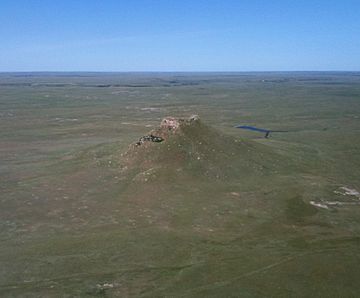Thunder Butte facts for kids
Quick facts for kids Thunder Butte |
|
|---|---|
 |
|
| Highest point | |
| Geography | |
| Geology | |
| Orogeny | Differential erosion |
| Age of rock | Paleocene (66 - 57 mya) |
Thunder Butte (Lakota: Wakíŋyaŋ Pahá) is a prominent butte landmark located in the northwest corner of Ziebach County, South Dakota, in the United States. Thunder Butte is a landform that can be seen for many miles in every direction, and serves now (as it has in the past) as an important orientation point for area residents, or a navigational aide for travelers crossing the surrounding plains. The prominent butte gives its name to a small community at its base, and to a small creek that runs into the Moreau River.
Contents
Geography
Thunder Butte was formed by differential erosion. Its summit is 2,733 feet (833.02 meters) above sea level, and rises some three to five hundred feet (90 - 150 metres) above the surrounding grasslands. Thunder Butte is the highest point in Ziebach County. Thunder Butte lies on the drainage divide between the Grand River, to the north, and the Moreau River to the south; both rivers drain eastward to the Missouri.
The butte is located about 75 miles (120 km) west of the Missouri River, and about 105 miles (170 km) northeast of the Black Hills, (both distances as the crow flies). The geographical coordinates of Thunder Butte (Wakinyan Paha) are Latitude N 45.319978 (49 19 12 N) and Longitude W -101.880704 (-101 52 51 W). The butte lies in the Southeast quarter of Section 26 of Township 16 North, Range 18 East.
Native Americans and Thunder Butte
Thunder Butte is “Wakinyan Paha” in the language of the Lakota people, to whom the butte has historic, religious and cultural significance. In traditional Lakota lore, thunder originated on the butte. The Lakota Sioux tribe has resided in this area since about 1776, after driving out the Cheyenne, (who had driven out the Kiowa, who had in their turn driven off previous Native American possessors.) A high concentration of Lakota Sioux people still reside around the Thunder Butte landmark -- Ziebach County, where Thunder Butte is located, has a 72.29% Native American population. The prominent landmark is clearly visible from two surrounding reservations of the Lakota and Dakota Sioux people; the butte is within the Cheyenne River Indian Reservation which has Lakota people from four bands/tribes of the Lakota nation, and the butte is only a short distance from the southern boundary of the Standing Rock Indian Reservation which has people of the Lakota and Dakota nations
Geology
Thunder Butte has an erosion resistant cap of harder Paleocene age sedimentary rock known as the Ludlow Formation. Lower elevations of surroundings grasslands/plains are underlain by the softer and more easily eroded Hell Creek sedimentary rock. The cap of Ludlow Formation rock is an erosional remnant, and other buttes in this area of western South Dakota are also capped by similar Ludlow Formation erosional remnants. Geological maps are available online, which show Thunder Butte, and its cap of the Ludlow Formation; see the 15 minute (1:62,500 scale) Glad Valley geologic map, which can be viewed and downloaded from the SD Geological Surveys website. The regional geological aspect can also be viewed on the Geologic map of South Dakota, but Thunder Butte's cap of Ludlow Formation rock is too small a feature to be shown on the regional map with its larger 1:500,000 scale.
Other geographical features and locations named after Thunder Butte
Thunder Butte Creek originates to the west of the butte, and flows by the southwest side of the butte, and then extends southeasterly to join the Moreau River. The small unincorporated community of Thunder Butte is located near this river junction at these geographical coordinates: Lat. 45.21166 N, Long. -101.670016 W.


